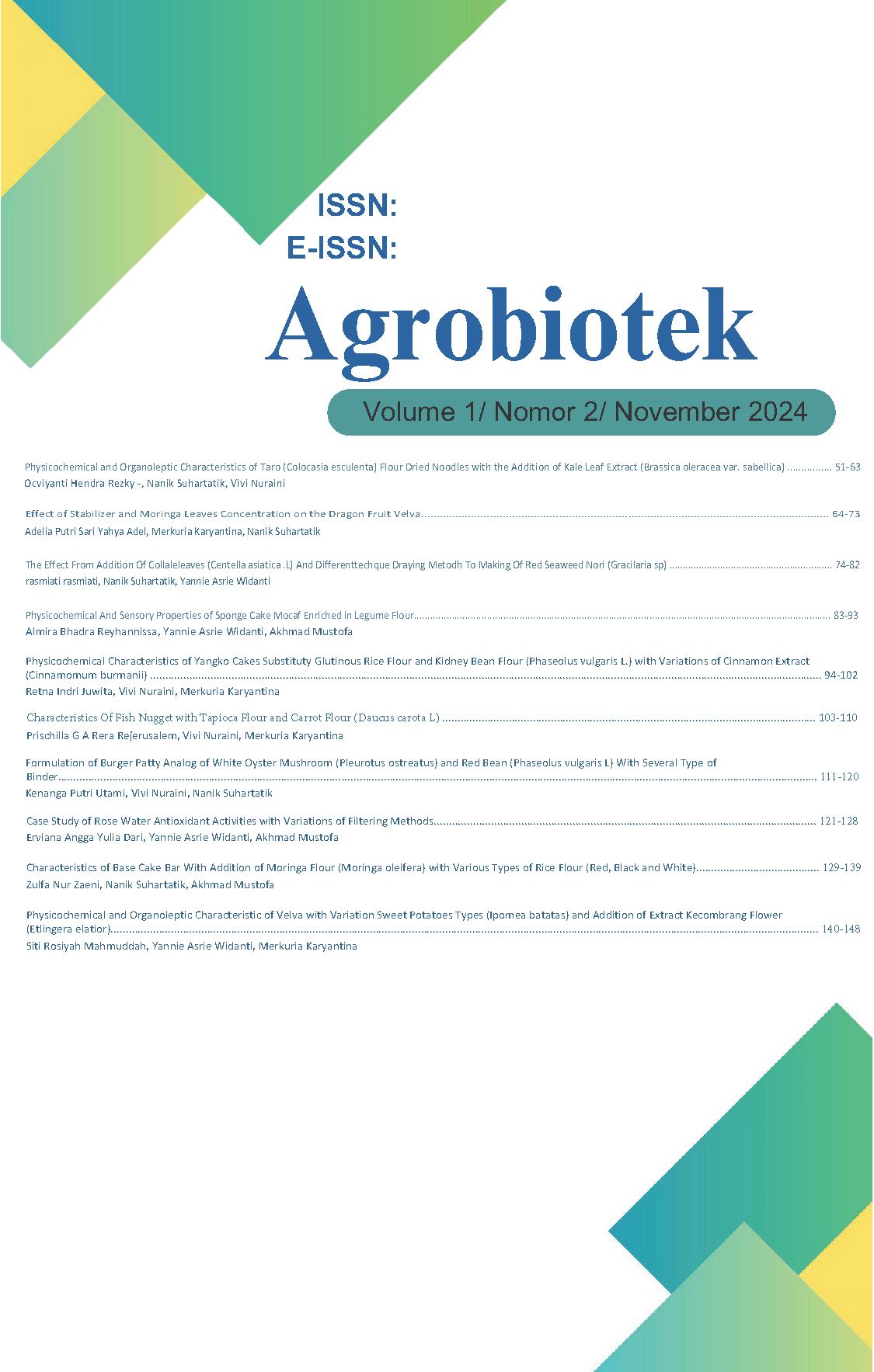Physicochemical Characteristics of Yangko Cakes Substituty Glutinous Rice Flour and Kidney Bean Flour (Phaseolus vulgaris L.) with Variations of Cinnamon Extract (Cinnamomum burmanii)
Karakteristik Fisikiokimia Kue Yangko Substitusi Tepung Ketan dan Tepung Kacang Merah (Phaseolus vulgaris L.) dengan Variasi Ekstrak Kayu Manis (Cinnamomum burmanii)
DOI:
https://doi.org/10.33061/agrobiotek.v1i2.9830Keywords:
Cinnamon extract, kidney bean flour, yangkoAbstract
Yangko cake is a semi-wet food made from glutinous rice flour with the addition of a sugar solution. In order to improve the characteristics of the yangko cake, an ingredient is added, namely kidney bean flour and cinnamon extract. Kidney beans are one type of legume that has a high protein source so it can add nutritional value to food products. Kidney bean has an unpleasant taste, therefore it needs to be balanced with the addition of cinnamon extract, which is expected to reduce the unpleasant flavor of the yangko cake which consumers preferred. The experimental design used is a CRD, with the first factor being the ratio of glutinous rice flour and kidney bean flour with a ratio of 90:10, 80:20, and 70:30. The addition of cinnamon extract in various amounts (2 ml, 4 ml, and 6 ml) was the second element. The inclusion of substitute glutinous rice flour and kidney bean flour, coupled with the variation of cinnamon extract produced yangko cake with 3,80% fiber content and 5,76% protein content. Chemically, physically and organoleptically, the best product from several formulations of the yangko cake was with 70:30 of glutinous rice flour to kidney bean flour and 6 ml of cinnamon extract, with 47.98% water content, 0.66% as content, 31,36% total sugar content and with a hardness of 28.82 N, a gumminess of 4.92 N, a chewiness of 2.28 N then a cohesiveness of 0.64 Ns. The organoleptic characteristic of the yangko cake was the most preferred by the panelists, with a value of 3,76 (preferred). The yangko cake substitusion of glutinous rice flour and kidney beans with the addition of cinnamon extract is a food ingredient that has quite high protein and fiber.
References
Annisa, I., & Ninik, R. (2015). Indeks glikeimik, beban glikeimik, kadar protein, serat, dan tingkat kesukiaan kue keriing tepiung garut dengan substitusi tepunig kai.cang m.ieriah. Journal of Nutrition College, 4(2), 620–627. https://doi.org/https://doi.org/10.14710/jnc.v4i4.10.171
Aprianto. (2011). Ekstraksi oleoresin dari kayu manis berbantu ultrasonik dengan menggunakan pelarut alkohol. Skripsi. Semarang: Universitas Diponegoro.
Faizal, R. (2016). Opti.mialisasi forimulasi tepunig ha.injeli dia.n tepiung kaicang meirah teri.hadap karaikteristik food bar dengian men.gigunakan d.esign expert metoda d-optimal. Skrispsi. Bandung: Universitas Pasundan Bandung.
Fatimah, P. T. et al. (2013). Uji daya terima dan nilai gizi biskuit yang dimodifikasi dengan tepiung kaicang meirah. Jurnal Kesehatan Masyarakat, 2(6), 1–7.
Haliza, W., Kailaku, S. I., & Yuliani, S. (2017). Penggunaan Mixture Response Surface Methodology pada optimasi formula brownies berbasis tepung talas banten (xanthosoma undipes k. koch) sebagai alternatif pangan sumber serat. Jurnal Penelitian Pascapanen Pertanian, 9(2), 96. https://doi.org/10.21082/jpasca.v9n2.2012.96-106
Karyantina, M., Suhartatik, N., & Prastomo, F. E. (2021). Potensi ekstrak kayu manis (Cinnamomum burmannii) sebagai senyawa antrimokriobia pada edible film pati sukun (Artocarpus communis). Jurnal Teknologi Hasil Pertanian, 14(2), 75.
https://doi.org/10.20961/jthp.v14i2.48363
Shaliha, L. A., Abduh, S. B., & Hintono, A. (2017). Antioxidant activity, texture, and lightness purple sweet potato (Ipomoea batatas) steamed on various heating time. Jurnal Aplikasi Teknologi Pangan, 6(4), 141–144.
Suladra, M. (2020). Pengaruh penambahan ubi jalar ungu (Ipomea batatas. L) terhadap sifat organoleptik dan aktivitas antioksidan pada kue yangko. Agrotech : Jurnal Ilmiah Teknologi Pertanian, 3(1). https://doi.org/10.37631/agrotech.v3i1.171
Szczesniak, A. S. (2002). Texture is a sensory property. Food Quality and Preference, 13(4), 215–225. https://doi.org/10.1016/S0950-3293(01)00039-8
Tiwari, B. K., Gowen, A., & Mckenna, B. (2011). Pulse Foods: Processing, Quality and Nutraceutical Applications. London: Elsevier
Downloads
Published
How to Cite
Issue
Section
License
Copyright (c) 2024 Retna Indri Juwita, Vivi Nuraini, Merkuria Karyantina

This work is licensed under a Creative Commons Attribution-ShareAlike 4.0 International License.
Authors who publish with this journal agree to the following terms:
- Copyright on any article is retained by the author(s).
- The author grants the journal, right of first publication with the work simultaneously licensed under a Creative Commons Attribution License that allows others to share the work with an acknowledgment of the work’s authorship and initial publication in this journal.
- Authors are able to enter into separate, additional contractual arrangements for the non-exclusive distribution of the journal’s published version of the work (e.g., post it to an institutional repository or publish it in a book), with an acknowledgment of its initial publication in this journal.
- Authors are permitted and encouraged to post their work online (e.g., in institutional repositories or on their website) prior to and during the submission process, as it can lead to productive exchanges, as well as earlier and greater citation of published work.
- The article and any associated published material is distributed under the Creative Commons Attribution-ShareAlike 4.0 International License







